
After reading this testimonial, you will come to understand the potential of EAUTARCIE techniques. In a waterless environment, the PLUVALOR system has allowed water-demanding activities, which would have been otherwise impossible. The reader will also observe the cost of mistakes for drinking water when the principles behind the PLUVALOR system are not accepted outright. It is instructive to read tourist reactions to the BioLitter Toilet (BLT) in a country lodge.
Unfortunately, greywater is here being treated (with huge evaporation losses) when it should rather be used to water plants, without any prior treatment and without health risk. That is imperative in such a dry area as Andalusia.
To see examples of EAUTARCIE homes that are self-sufficient and self-contained in terms of water consumption, click here.
The EAUTARCIE website has been adapted and translated from the French version by André Leguerrier architect, Montreal, Canada.
The text within this page was first published in French on www.eautarcie.com: in 2009
The original text has since been adapted and first published in English on this page at www.eautarcie.org: 2010-06-24
Last update: 2016-10-23
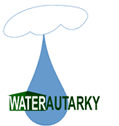
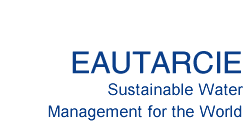
Testimonial from Andalusia
Introduction
We’re located in the small Andalusian town of Villanueva de Tapia, but an hour’s distance from Grenada or the Malaga airport. It’s a completely isolated site, without mains water supply, electricity, sewers or telephones. We therefore had to take up the challenge of living autonomously while at the same time making the facility accessible to the public.
We can be contacted at:
http://ecogite-insolite-andalousie.over-blog.com/pages/Accueil-7594453.html
Our facilities currently accommodate camping in tents and lodging in yurts, a guesthouse, or in a studio.
The water table is located at a depth of 150 m and contains hard and brackish water. We have therefore given up on boring a well.
Andalusia’s inhabitants tend to say that it never rains, or that in any case, it doesn’t rain enough. This isn’t what we’ve observed. Even though we come from Northern Europe, we have noted that local rainfall is far from negligible, even if rain events are rather spread out irregularly throughout a year.
During the first year, rainfall totalled 15 to 35 litres per m². To catch this rainfall, we installed gutters on all available roofs. For lack of locally available concrete cisterns, we built our own masonry cistern, made watertight with a cement/lime mortar lining.
During our first winter, our 11-m³ cistern overflowed. It was obviously under-sized. This showed that the only realistic solution for us was to go the way of rainwater harvesting. We were therefore quite glad to abandon the chore of getting water from the neighbouring village to cover our domestic needs.
Thanks to the discovery of Professor Országh’s EAUTARCIE website, we came to understand that water autarky was at hand’s reach. This became our objective. Initially, in spite of the EAUTARCIE website’s recommendations, we were not wholly confident in our filtered rainwater’s potable quality. For lack of finding a lab to test this water, we continued to fill our bottles at the village springs for over a year.
It wasn’t until end of November 2008 that we finally found a pharmacy that could analyze our water. To our utter relief, the analysis of our rainwater was positive: it complied with Spain’s potable water standards.
Had we had faith from the start in the EAUTARCIE system, we could have been spared a year’s worth of water chore. We now fully agree with Mr. Országh when he asserts, « in the near future, the only available source of quality drinking water available to all will be rain ». This is already true in Andalusia.
For our autonomy (family + visitors), we have already installed a cistern storage capacity of close to 40 m³, which still seems a bit short to catch the entirety of rainfall on our roofs. This is probably due to the rainfall’s irregularity.
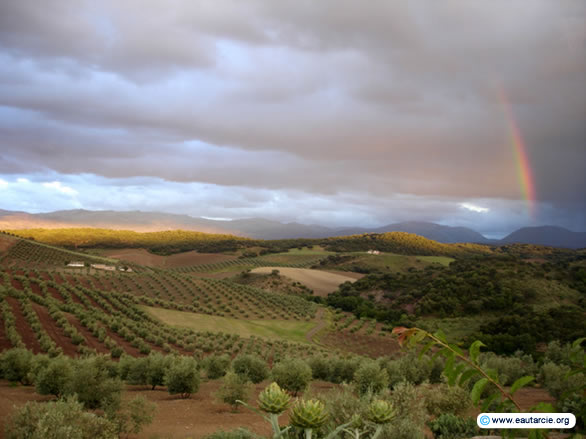
Typical Andalusian topography
Technical Characteristics of our Set-up
Roof Area
House: 75 m², solar panels: 7,2 m², small miscellaneous roofs: 6 m², large guesthouse: 25,38 m². for a total of 114 m².
Water Storage
Water is stored in many cisterns:
- An 11-m³ masonry cistern as mentioned above, with tile flooring. Upstream from this cistern, there’s a sedimentation basin that receives water from roof runoff.
- An 8-m³ cistern made of food-grade polyester. It is used as a « water tower » as it is buried in the higher part of our terrain. Water is pumped from the 11-m³ cistern to the 8-m³ cistern, and is thereby gravity-fed to the house.
- A 12-m³ polyester cistern installed on the ground. It will soon also be buried at the top of our terrain.
- Six 1-m³ food-grade polyethylene cubes.
- A 2-m³ polyester cistern to harvest water from the large guesthouse.
For a total storage capacity of 39 m³, of which 31 m³ is directly connected to the roofs.
Equipment
- A hydrophor pressure-tank system, 100% electrically-fed with solar and wind energy.
- A Cintropur brand 25-micron filtering unit, placed downstream from the pump.
- A microfiltration system (primary filter + ceramic cartridge + activated carbon) for drinking water production in the kitchen and studio.
- A standard water-meter to monitor total consumption.
- A water-meter for our guests’ outside kitchen.
- A water-meter for the guesthouse and the yurts.
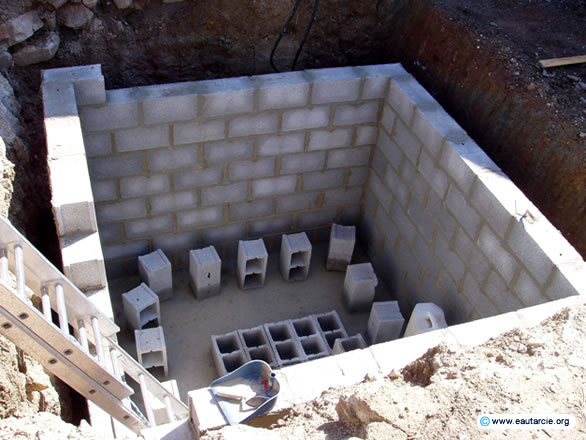
The 11-m³ masonry cistern during construction
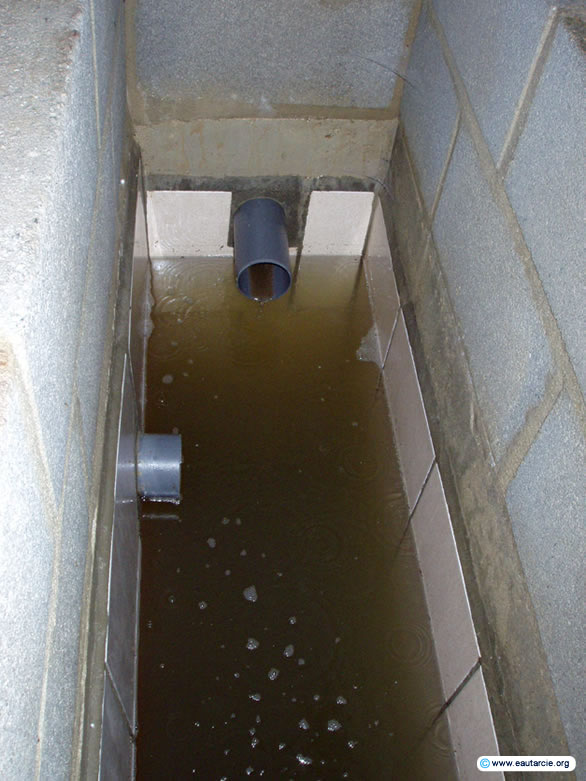
The sedimentation basin upstream from the cistern
Greywater Purification
From the Studio
Greywater produced by the studio goes through a grease-trap laden with straw, then into a tank formed by a concrete cylinder measuring 1 m deep by 80 cm diameter. The wastewater settles at the bottom. The overflow drains into a second tank from which the water is pumped to be stored in a cistern that is used to moisten the compost and water the vegetable garden and olive trees.
From the Guesthouse
The guesthouse greywater goes through three planted filtering basins (with aquatic plants), with a 40-cm gradient level difference between each successive basin. In each one, the wastewater must percolate upwards through 4 layers of mineral aggregates. Each basin contains a layer of larger stones, covered with a layer of volcanic rock, and than a layer of small gravel, and finally a layer of sand. The plants that line each basin were taken from the shore of a small creek at the bottom of our terrain.
Water from the fourth basin is used for irrigation.
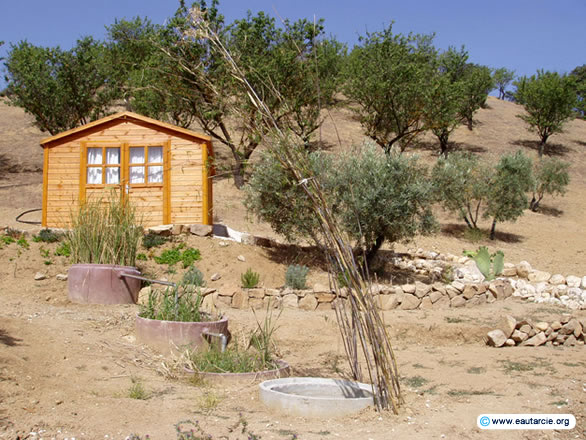
Greywater filtering basins
Analysis of our Filtered Rainwater
| Parameters | Units | Values | Drinking Water Standards |
| Colour | 0,2 | No standard | |
| Odour | Normal of 3 at 25°C | No standard | |
| Turbidity | FNU | 2 | <1 |
| Conductivity | µS/cm | 163,6 | <400 |
| pH | - | 7,53 | 6,5 to 9,5 |
| Ammonium (NH4+) | mg/litre | 0,017 | <0,5 |
| Nitrite ions (NO2-) | mg/litre | 0,020 | <0,5 |
Total germs |
|||
| at 22°C at 37°C |
Ufc/ml |
40 38 |
<100 <100 |
| Escherichia coli | Ufc/ml | None found | No standard |
| Total coliforms | Ufc/ml | None found | No standard |
| Faecal coliforms | Ufc/ml | None found | No standard |
Testimonials from our Guests on Water and Dry Toilets
- After their stay at our facility, a couple with three children aged 3, 6 and 9 years old decided to remove their flush toilets at home, to replace them with litter toilets.
- A father raising his two kids aged 9 and 15 years old asked me to make his children better aware of their water and energy consumption. He said: « When counselled by strangers rather than their parents, children tend to listen better and are more mindful, lending such counsels a greater impact ». In his opinion, measuring water consumption at the start and at the end of their stay was a good idea. Thus, you can calculate the average daily consumption per person, and even monitor water use on a daily basis if you so choose. I also explained the simple yet responsible gestures that could be carried out daily towards energy savings. The father, who lives in Paris, having already read about litter toilets wished to follow up on this and help his children discover the environment.
- One couple came to realize that anyone could shower with three litres of water, enough to fill two 1.5-litre flasks.
- A couple with two children aged 4 and 5 insisted on coming to our facility to make them better aware of the need to save water. Their kids usually let the faucet flow while brushing their teeth, let the water flow when showering and never shut out the lights when leaving a room. After less than three days at our lodgings, the children came to understand the importance of these issues, and their mom was utterly satisfied.
- Another couple arrived with two children. The husband wanted to install litter toilets at home, against his wife’s wishes. The « opponents » were astonished to observe that at temperatures above 35°C, there were no flies or odours in the toilet, and no more so around the compost heap.
Concerning dry toilets, the absence of odours seems to be the decisive argument for most families.
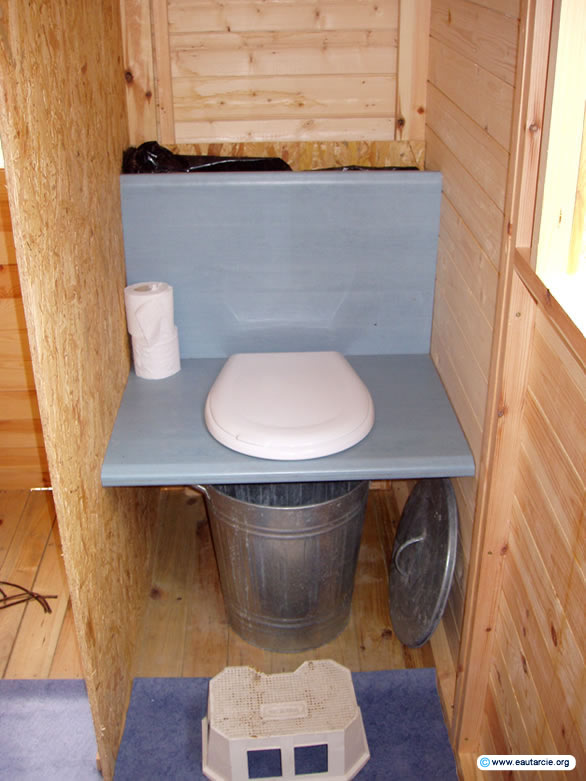
Our guests’ dry toilet (litter toilet)
Drinking Water
After arriving in Spain, we strictly purchased bottled water to renew our store of water flasks. During the first year, these were used to carry (chlorinated) mains water taken up at the village taps.
After some time of using mains water, we opted to take our drinking water from a spring that was pointed out by village elders; a spring that delivered fresh water that appeared to be of good quality. We preferred this water, in spite of the fact that it was officially declared « non potable ».
The next summer, « our spring » became a trickle of water. We therefore had to find another spring further away. As expected, the second spring was also declared « non potable ». This did not prevent us to take our water there. Spaniard women also did. This spring’s water had a pleasant taste, but it made us go to the toilet quite often.
Intrigued by this water’s sanitary side effects, we asked that the communal authorities analyse it. Thus we learned that both springs delivered water containing a nitrate content exceeding the legal limit of 50 mg/l.
On the same occasion, I had our rainwater analysed by a pharmacy, with the positive results mentioned above. It’s sad to say, but we waited over more than a year before realizing that our harvested rainwater was of far better quality than mains water supply, but also better than the village springs. We are now wholly convinced and decided to drink our filtered rainwater. Having good quality drinking water is possible with simple means.
A Few Examples of Water Concerns in Andalusia
Encouraged by our experience, we got interested in the neighbouring town’s water problems. I thus learned that nitrates gravely polluted our region’s water table. The town’s inhabitants are supplied with potable water transported by tank trucks.
This same scenario could be occurring in other Andalusian villages, due to intensive agriculture. Already now, water shortages have progressively set-in: some towns are rationed without water for periods extending up to 15 days.
During our summer excursions, we decided to go see Lake « Pantano del Agujero » near Malaga. Upon our arrival, in spite of the road signs indicating where to find the lake, no stretch of water could be found. Questioned, a Spanish passer-by told us that were effectively near the lake shown on the map. But in lieu of water, a deep vegetation-strewn valley could be seen. Which lent us to believe that there hadn’t been water in this reservoir for quite some time.
This lake/reservoir/dam was supposed to provide drinking water for parts of the provinces of Seville and Cordova. Franco had created it in 1979.
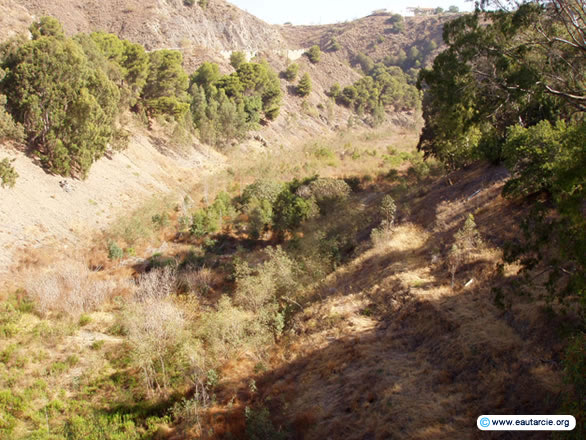
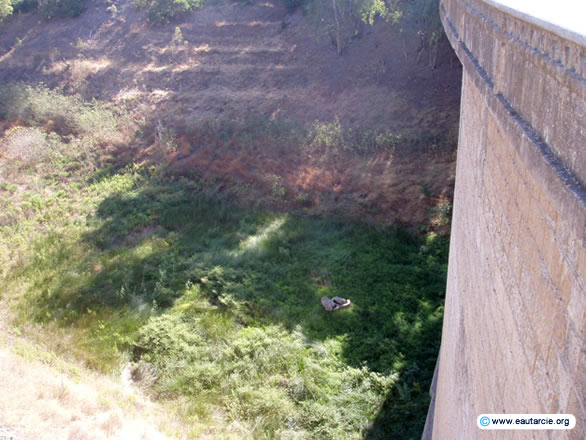
Pantano del Agujero – all dried up
My Answers to a Survey for an Ecotourist Vacation Guide – on the Question of Water
Do you use low-flow faucets and showerheads?
Yes, even though the hot water heater doesn’t allow a flow of more than 5 litres of water per minute.
Do you have dual-flush or low flush WC toilets?
We have no flush toilets, only litter toilets that require wood shavings instead of water, with the use of reclaimed millwork residues.
Do you have a rainwater harvesting system?
Yes. Each square meter of roof is used to harvest rainwater. It’s our only source of water. We have no other alternative, but it suffices. We never lack water.
Do you have a greywater recycling system?
Yes. The entirety of greywater produced is purified and reused to water the vegetable garden, the orchard, and to moisten our compost heap. We cannot allow for wastage of water, which is so precious in Andalusia.
The treated greywater is stored in a cistern. Thus, it’s available when we need it.
Have you taken other measures, not mentioned above, to reduce or manage your water consumption?
Upon their arrival, our guests are informed that the buildings are not serviced by a public distribution system. We also underline that there is no well or spring on our land. All water used comes from rainwater cisterns.
Water being scarce, saving it becomes self-explanatory. If the cisterns were to dry up, we would have to get water from the village. This would be expensive for everyone.
This explains the installation of a water meter, which helps us monitor consumption and manage our reserves. At our facility, hands-on experience is the way of learning the daily gestures of proper water use. It’s an excellent school of responsible management that one can practice at home, back from vacation.
Calculating a person’s daily water requirements is not only a precious indicator to help adjust one’s behaviour, but is also a fun arithmetic activity, mainly for children, when applied to ecological living.
Our guests are sometimes surprised to learn that their daily water consumption for personal hygiene levels out at about 20 litres per day per person. This is less than half of what they use up at home. The kitchen requires about 5 litres per day per person. I also tell them that were they to install a litter toilet at home, they would reduce their water bill by about 30 %.
At our facility, a vacation is also an initiation to ecology.
By Véronique
Villanueva de Tapia, January 25 2009.




